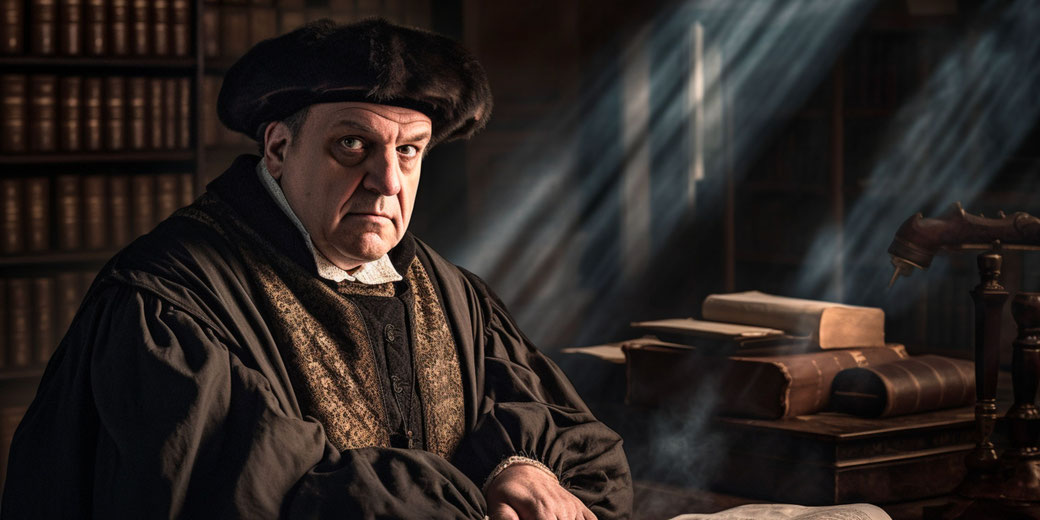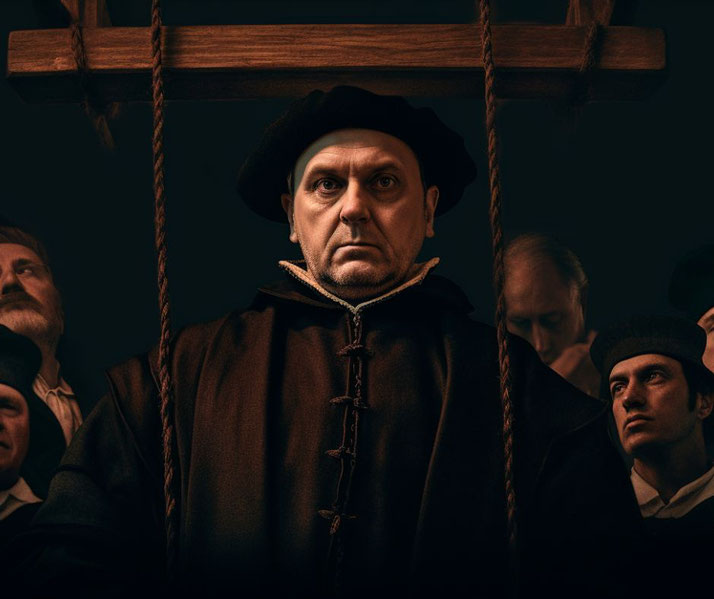Thomas Cromwell: Hero or villain of Tudor England?

Thomas Cromwell is one of the most controversial figures in English history, a man whose influence reached into the very heart of Tudor politics and religion.
Born to a blacksmith in Putney, Cromwell rose through the ranks to become King Henry VIII's chief minister, a position that allowed him to shape the course of a nation.
His role in the English Reformation, the dissolution of the monasteries, and the complex marital affairs of Henry VIII forever altered British history.
Yet, despite his meteoric rise, Cromwell's fall was equally swift and brutal, culminating in his execution in 1540.
Thomas Cromwell's early life
Thomas Cromwell was born around 1485 in Putney, London, into a family far removed from the corridors of power.
His father, Walter Cromwell, was a blacksmith, brewer, and cloth merchant, and the young Cromwell's early years were likely marked by the challenges and opportunities of a working-class upbringing.
Despite these humble beginnings, Cromwell showed an early aptitude for learning and ambition that would serve him well in the years to come.
He left England at a young age, seeking experience and education on the European continent.
His travels took him through Italy, the Low Countries, and perhaps even as far as the Ottoman Empire, exposing him to a range of cultures, languages, and, most importantly, ideas.
Upon his return to England, Cromwell entered the service of Cardinal Thomas Wolsey, a powerful and influential figure in the court of King Henry VIII.
Wolsey recognized Cromwell's talents and put him to work on various legal and administrative tasks, effectively becoming his mentor.

Service under Cardinal Wolsey
Wolsey was a man of immense influence and power, serving as both the Lord Chancellor of England and the Archbishop of York.
His close relationship with King Henry VIII made him one of the most powerful men in the kingdom, and his patronage was sought by many.
When Cromwell returned to England after his years abroad, it was Wolsey who recognized his potential and took him under his wing.
In Wolsey's service, Cromwell honed the skills that would later make him indispensable to the King.
He was involved in a range of activities, from legal affairs to diplomatic missions, and he gained a reputation for efficiency, intelligence, and discretion.
Cromwell's work for Wolsey, particularly in the area of law and administration, gave him a practical education in governance that few could match.
It was a formative period that shaped his understanding of power, politics, and the law.

Cromwell's rapid rise to power
However, Wolsey's fall from grace in 1529 served as a critical lesson for Cromwell in the volatility of royal favor.
Wolsey's inability to secure an annulment for Henry VIII's marriage to Catherine of Aragon led to his rapid downfall.
Stripped of his titles and property, Wolsey died in disgrace, but not before imparting a final lesson to his protégé: the need for adaptability and survival in the treacherous landscape of the Tudor court.
Cromwell took this lesson to heart. He managed to disentangle himself from Wolsey's downfall and transition into the service of Henry VIII, a move that required both skill and a fair amount of audacity.
Cromwell's rise to power was meteoric. By 1532, he had become a member of the King's inner circle, and within a year, he was appointed to the Privy Council.
His influence grew exponentially when he was made Master of the Rolls in 1534.
His legal acumen and skill in administration quickly caught the eye of Henry VIII, who was embroiled in what would become known as his "Great Matter"—the quest to annul his marriage to Catherine and marry Anne Boleyn.
The King's "Great Matter": The Divorce of Henry VIII
Thomas Cromwell found himself at the epicenter of this tumultuous period, and his role in resolving the King's marital woes would be one of the defining moments of his career.
Henry VIII's marriage to Catherine had produced no male heir, a situation that threatened the Tudor dynasty and weighed heavily on the King.
His eyes had turned to Anne Boleyn, a lady-in-waiting to Queen Catherine, and he became convinced that his marriage to Catherine was cursed and thus invalid.
The Pope, however, was unwilling to grant an annulment, partly due to political pressures as Catherine was the aunt of Charles V, the Holy Roman Emperor.
This deadlock set the stage for Cromwell's intervention.
Cromwell, leveraging his legal expertise and understanding of parliamentary procedure, proposed a radical solution: break away from the authority of the Pope and establish Henry as the Supreme Head of the Church of England.
This was a daring move, fraught with risk, but it offered a way out of the impasse.
The English Reformation and the Act of Supremacy.
While the King's "Great Matter" had set the stage for a break with Rome, it was the Act of Supremacy in 1534 that formalized this schism and laid the groundwork for the English Reformation.
The Act declared Henry VIII the Supreme Head of the Church of England, effectively severing all ties with the Pope and the Roman Catholic Church.
This was a revolutionary act, one that altered the very fabric of English society, politics, and religion, and Cromwell was its chief architect.
Cromwell recognized that the Act would face opposition, not just from devout Catholics but also from those who feared the political implications of such a move.
Therefore, he employed a combination of persuasion, negotiation, and, when necessary, intimidation to secure its passage.

The Dissolution of the Monasteries
One of the most controversial and far-reaching actions orchestrated by Thomas Cromwell was the Dissolution of the Monasteries, a campaign that began in 1536 and continued until 1540.
The monasteries were not just religious institutions; they were also major landowners and centers of learning and charity.
Cromwell initiated the dissolution by commissioning a series of "visitation" surveys to assess the state of the monasteries.
These surveys, often criticized for their bias and lack of rigor, painted a picture of moral and financial corruption that was used to justify the closures.
Once the reports were in, Cromwell moved swiftly. Smaller monasteries were the first to be dissolved, their lands and assets seized by the Crown.
The larger and more influential abbeys and priories soon followed. Cromwell was meticulous in managing the legal and administrative aspects of the dissolution, ensuring that the process, though rapid, was carried out under the color of law.
The economic impact of the dissolution was immediate and immense. The Crown acquired vast tracts of land and significant wealth, much of which was used to fund Henry VIII's military campaigns and bolster the royal treasury.
Many nobles and gentry also benefited, purchasing monastic lands at favorable rates.
However, the social consequences were equally significant and far less positive.
The dissolution led to the loss of charitable services provided by the monasteries, including education, healthcare, and alms for the poor.
It also resulted in significant unemployment and social dislocation, contributing to public unrest, most notably the Pilgrimage of Grace.
Cromwell's role in the Pilgrimage of Grace
The Pilgrimage of Grace in 1536 was one of the most significant uprisings against the Tudor monarchy and posed a direct challenge to the religious and social reforms that Thomas Cromwell had championed.
Originating in the north of England, this rebellion was a complex mix of grievances, but at its core was a deep-seated opposition to the Dissolution of the Monasteries and the broader religious changes being implemented.
Cromwell found himself in a precarious position. On one hand, he was the architect of the very policies that had sparked the rebellion; on the other, he was one of the key figures responsible for suppressing it.
The King's trust in him was implicit, but the stakes were high. A failure to quell the uprising could result in his downfall, and perhaps even his death.
Cromwell's response to the Pilgrimage of Grace was a blend of military action and political maneuvering.
While royal forces were mobilized to suppress the rebellion, Cromwell also engaged in a campaign of promises and disinformation to sow discord among the rebel ranks.
He advocated for a strategy that combined force with promises of pardon and redress for grievances, aiming to break the rebel alliance without resorting to widespread bloodshed.
The rebellion was eventually suppressed, but not without significant concessions, including a slowdown in the pace of monastic dissolutions and a more cautious approach to religious reform.
The suppression of the Pilgrimage of Grace was a victory for Cromwell, but it was a victory tinged with caution.
The rebellion had exposed the fault lines in his policies and revealed the extent of public opposition to his reforms.
Cromwell's need for political alliances
Cromwell's role in the English Reformation and the Act of Supremacy solidified his reputation as one of the most innovative and daring statesmen of his time.
Yet, these actions were not without cost. They made him enemies, both at home and abroad, and set him on a collision course with those who viewed the religious changes as heretical or politically dangerous.
One of Cromwell's most significant alliances was with Archbishop Thomas Cranmer, a fellow reformer and a key figure in the English Reformation.
Together, they worked to advance the cause of religious reform, often against significant opposition from conservative elements within the court and the country.
This alliance was instrumental in pushing through some of the most radical religious changes of the period, including the Act of Supremacy and the dissolution of the monasteries.
On the other side of the ledger were Cromwell's rivals, men like Thomas More and Edward Seymour, who represented different but equally challenging threats to his position.
More, a devout Catholic and a brilliant scholar, was a vocal opponent of the religious reforms that Cromwell championed.
His refusal to acknowledge Henry VIII as the head of the Church of England led to his execution, a grim reminder of the stakes involved in Tudor politics.
Seymour, on the other hand, was a more traditional rival, representing a noble family that sought to increase its power and influence at court.
The rise of Jane Seymour, Henry VIII's third wife, provided her family, including Edward, with a platform to challenge Cromwell's influence.
Cromwell's conflict with the Seymour family
Jane Seymour, Henry VIII's third wife, became queen just days after Anne Boleyn's execution in 1536.
Her family, particularly her brother Edward Seymour, saw their influence at court grow exponentially as a result.
For Cromwell, the Seymours initially represented a political opportunity. Jane was more amenable to his religious reforms than Anne Boleyn had been, and her family, especially Edward, seemed like potential allies in his efforts to consolidate the English Reformation and strengthen the Tudor monarchy.
However, the alliance between Cromwell and the Seymours was fraught from the start.
Edward Seymour was ambitious, and as his sister produced the long-awaited male heir, Edward VI, in 1537, he began to see himself as the natural leader of the English nobility and a potential successor to Cromwell as the King's chief minister.
The tension between Cromwell and the Seymours reached a boiling point over the issue of Henry VIII's next marriage after Jane Seymour's untimely death in 1537.
Cromwell saw an alliance with the Protestant Duchy of Cleves as politically advantageous and helped arrange the King's marriage to Anne of Cleves.
Edward Seymour and other conservative nobles at court were opposed to the match for both political and religious reasons.
The marriage between Henry VIII and Anne of Cleves was a disaster from the start, with Henry finding Anne physically unattractive and the union remaining unconsummated.
This provided Seymour and his allies with the ammunition they needed to challenge Cromwell's position.
Cromwell's fall from grace in 1540 was swift and brutal, and the Seymour family played a significant role in his downfall.

Cromwell's dramatic downfall and execution
Cromwell was arrested in June 1540, accused of heresy and treason. The charges were likely exaggerated, but they were enough to turn the King against his once-trusted advisor.
Cromwell's arrest was a shock to the English political system, and it sent a clear message about the dangers of falling out of royal favor.
Despite his years of loyal service and the transformative policies he had enacted, Cromwell found himself isolated and powerless, a victim of the very political machinations he had once mastered.
His trial was a foregone conclusion. Stripped of his titles and property, Cromwell was condemned to die without the benefit of a full trial by jury.
He was executed on July 28, 1540, the same day that Henry VIII married his fifth wife, Catherine Howard.
The speed and severity of Cromwell's downfall were a testament to the precariousness of life at the Tudor court, where even the most powerful figures were never more than a step away from disgrace and death.
What do you need help with?
Download ready-to-use digital learning resources
Copyright © History Skills 2014-2024.
Contact via email
With the exception of links to external sites, some historical sources and extracts from specific publications, all content on this website is copyrighted by History Skills. This content may not be copied, republished or redistributed without written permission from the website creator. Please use the Contact page to obtain relevant permission.





